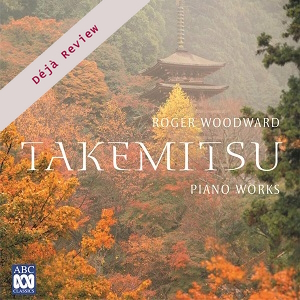
Déjà Review: this review was first published in August 2002 and the recording is still available.
Toru Takemitsu (1930-1996)
Complete Piano Music
Rain Tree sketch (1982)
Les yeux clos I & II (1979, 1989)
For Away (1973)
Litany (1950-1989)
Piano Distance (1961)
Uninterrupted Rests (1952-59)
Corona (1962)
Crossing (1962)
Roger Woodward (piano)
Rolf Gehlhaar (bowed cymbal)
rec. 1990, ABC Studios, Sydney; live, 16 September 1990, Art Gallery of New South Wales, Sydney, Australia (Corona, Crossing)
ABC Classics 446 739-2 [78]
This CD throws light onto an aspect of Takemitsu’s art, which until now has been little known. You may associate him with those sensual, delicately orchestrated tone pictures like ‘November Steps’ or ‘Riverrun’, which were recorded with much praise during his lifetime. The delicacies of these scores are like painted Japanese screens, subtle and spacious. These piano pieces, spanning almost forty years, span different styles, as one might expect of any composer and not, in many cases, sounding particularly Japanese. It is therefore of interest to see where Takemitsu was coming from before the renowned orchestral works of the last decade or so of his life. I will briefly discuss them in chronological order.
Despite the fact that the booklet (written in 1990 when the composer was very much alive) says that the works are dated from 1952, ‘Litany’ dates from 1950 in its original form and “it is only the refined treatment of certain details that suggest the intervening hand of the Old(ish) master”. This almost romantic work dedicated to the memory of Michael Vyner betrays Takemitsu’s love of three composers in particular, Debussy, Scriabin and Messiaen. The latter is very noticeable in ‘Uninterrupted Rests’ also known as ‘Three poems on a text of Takiguchi Shuzo’. The hothouse harmonies may remind listeners of Messiaen’s Preludes for piano of 1929. But with ‘Piano Distance’ of 1961 we enter another world, that of the Darmstadt avant-garde and of those composers intrigued by the sound-world of Messiaen’s ‘Mode de valeurs et d’intensités’ (1949) or even of Boulez’s piano sonatas. It is not an ingratiating work. Nor for that matter is the extraordinary ‘Corona’ and ‘Crossing’ of the following year. The violent and continuously powerful sounds of piano bass and scraping cymbal are, at first, gripping but as one piece grows imperceptibly into another the length as a whole seems too prolix.
‘For Away’ is a typical nocturnal meditation. I was reminded here of Kaikhosru Sorabji and a piece like ‘Le Jardin Parfumé’ (1923) and oddly enough even moments in Bernard van Dieren’s ‘Six Sketches’ for piano of 1911. I don’t imagine that Takemitsu had heard these composers’ music but each shares a fascination with the exotic. Another thing that they have in common is a love of a seeming lack of form and direction or, should I say, the ability to allow each piece to find its own form. Sorabji once declared that his music was the aural equivalent of a Persian rug, – highly elaborate decoration. Takemitsu once discussed listening to his music in terms of walking through a Japanese garden, luxurious and constantly changing in texture and colour, never the same – one pattern bouncing off another. After 1975 in most of his music this analogy is useful, as with both parts of ‘Les yeux clos’ (the second part of which, although Messiaen-inspired, appears to be a sequential development of the ‘Tristan’ chord – a clue to Takemitsu’s language) and similarly in ‘Raintree sketch’. I listened again to his ‘Rain Coming’ for chamber orchestra and ‘Rain Spell’ both also from 1982 (Virgin Classics nla) and realized that Takemitsu was born to write for orchestra, it is there that the exoticism of his art flourishes with the intoxicating wash of his favourite vibraphone, flute, strings and percussion and that the piano music always sounds like a sketch for the real thing – a uniquely colourful orchestral palette. I can now understand why in his large output only these few works survive for piano alone. The lines on one hand and the harmonies on the other are best brought out by strands of specific orchestral colour as I feel ‘Les yeux clos’ demonstrates.
Roger Woodward is a real Takemitsu expert with works such as ‘Uninterrupted Silence’ dedicated to him by the composer. He loves and understands this music, with its myriad difficulties, and is aided by an unspectacular but perfectly fine recording.
Gary Higginson
Help us financially by purchasing from



















